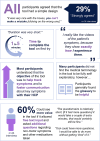Ethnographic evaluation of usability, understandability, and acceptance of the MY PD-CARE digital tool to facilitate Parkinson's disease symptom tracking and patients' and care partners' communications with the treating healthcare professional: the SELF-AWARE study
- PMID: 40679689
- PMCID: PMC12488775
- DOI: 10.1007/s10072-025-08342-0
Ethnographic evaluation of usability, understandability, and acceptance of the MY PD-CARE digital tool to facilitate Parkinson's disease symptom tracking and patients' and care partners' communications with the treating healthcare professional: the SELF-AWARE study
Abstract
Background and aim: The MY PD-CARE digital tool is intended to empower people with Parkinson's disease (PD) and care partners to actively identify and track changes in key symptoms of advancing PD and to facilitate discussions with healthcare professionals (HCPs). MY PD-CARE was adapted from MANAGE-PD, a validated, web-based tool that helps HCPs identify patients with inadequate symptom control. The SELF-AWARE (Study on Ethnographic research and human factors evaLuation For a tool to increase AWareness, self-Assessment, and Reporting of PD patiEnts uncontrolled on oral medication) study investigated MY PD-CARE ease of use, understandability, and acceptance among people with PD and their care partners.
Methods: SELF-AWARE was a non-interventional, cross-sectional, observational study. Participants (patients/care partners) assessed MY PD-CARE during 1-time virtual interviews conducted by trained medical anthropologists using qualitative ethnographic and human factor evaluation methods.
Results: In 90.7% of interviews (43 patients; 31 care partners), ≥ 1 patient/care partner participant was comfortable with technology. Most participants understood the purpose/objective of MY PD-CARE and agreed it was simple and easy to use. Although the medical terminology was not fully self-explanatory to many participants, half found the glossary helpful. Approximately 60% indicated MY PD-CARE could have more value with free-text input. Participants agreed that MY PD-CARE is useful for tracking symptoms and encouraging discussions with HCPs.
Conclusions: People with PD and their care partners perceived MY PD-CARE as useful and acceptable for tracking and increasing awareness of symptoms and facilitating discussions with HCPs. Participant feedback helped optimize the updated design of this digital tool.
Keywords: Chronic; Digital health; Health communications; Mixed methods; Neurology; Neuroscience.
© 2025. The Author(s).
Conflict of interest statement
Declarations. Ethical approval and consent to participate: This study was conducted in accordance with the ethical principles originating in the European Medicines Agency Module XVI Guideline on Good Pharmacovigilance Practices. The study was approved by an independent ethics committee as required by local laws and regulations. All study participants provided written informed consent. Conflict of interest: AA has received compensation for consultancy and speaker-related activities from AbbVie, Bial, Boehringer Ingelheim, Britannia, Ever Pharma, General Electric, Jazz Pharmaceuticals, Kyowa Kirin, Medscape, Neuroderm, Roche, Theravance Biopharma, UCB, and Zambon; has received research support from Angelini Pharmaceuticals, Bial, Cariparo Foundation, Horizon 2020 Grant 825785, Horizon2020 Grant 101016902, Lundbeck, Ministry of Education University and Research (MIUR), Movement Disorders Society, and Roche; and reports consultancy services for Boehringer Ingelheim for legal cases on pathological gambling. TH has received speaker honoraria from AbbVie, Britannia, Convatec, Ever Pharma, Lundbeck, Neuroderm, and Nordic Infucare; serves as a principal investigator for a study sponsored by AbbVie; and serves on the data monitoring committee for a study sponsored by Lundbeck. AH has no conflict of interest to disclose. LB and JCP are full-time employees of AbbVie and may hold AbbVie stock and/or stock options. PO has received compensation for consultancy and speaker-related activities from AbbVie, Bial, Britannia, Ever Pharma, Nordic Infucare, Stada, and Zambon, and has received royalties from Uni-Med Verlag. The authors have no other relevant financial or non-financial interests to declare.
Figures




References
-
- Schapira A, Chaudhuri KR, Jenner P (2017) Non-motor features of Parkinson disease. Nat Rev 18(8):435–450. 10.1038/nrn.2017.91 - PubMed
-
- Kuhlman GD, Flanigan JL, Sperling SA et al (2019) Predictors of health-related quality of life in Parkinson’s disease. Parkinsonism Relat Disord 65:86–90. 10.1016/j.parkreldis.2019.05.009 - PubMed
-
- Foltynie T, Brayne C, Barker RA (2002) The heterogeneity of idiopathic Parkinson’s disease. J Neurol 249(2):138–145. 10.1007/PL00007856 - PubMed
Publication types
MeSH terms
Grants and funding
LinkOut - more resources
Full Text Sources
Medical

